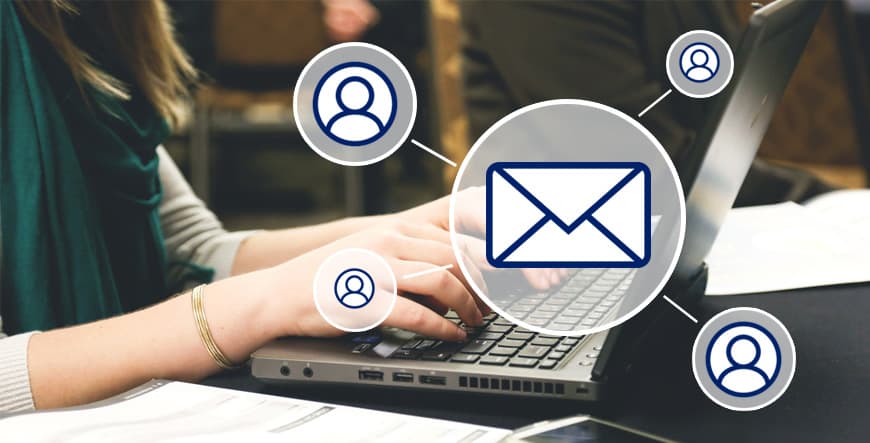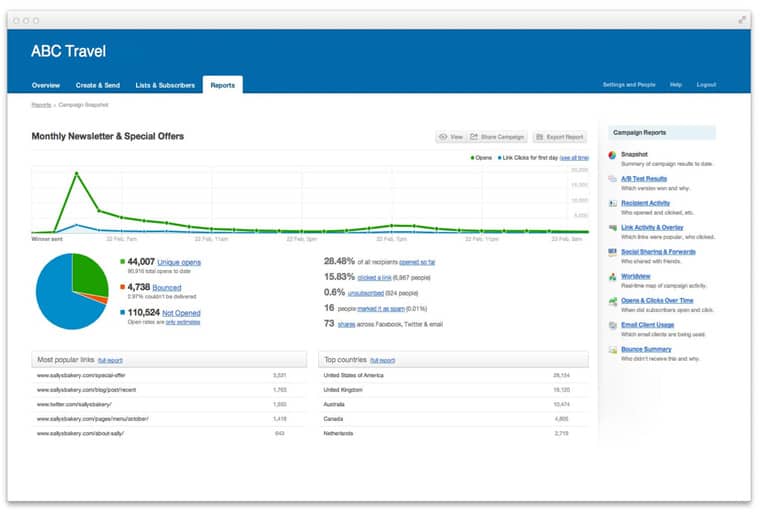Contents
Email Marketing

Contents
Email marketing is one of the most compelling methods of advertising. With mobile devices making it convenient for potential customers to compare brands, you can be assured that customers will see and receive your brand’s email messages regardless of where they are.
This convenience of time and place utility allows you to include real value in your emails, so the customers are excited to receive them and to engage with your program.
Awareness is the key to any strong marketing initiative, and the most suitable technique for creating awareness online is email. Email marketing can be utilized to develop trust with your clientele and turn them into repeat customers.
People would like to stay updated about your brand, and email marketing is the most effective way to engage with that audience.
Types of Emails
When discussing email marketing, there are three types of emails:
- Content emails
- Transactional emails
- Conversion emails
Content Emails
Content emails offer value to the user and cultivate your relationship and trust with them. The common example of content email is the welcome email, which is sent to the customers after they have registered or opened an account on your website.
This email can include a quick overview of your brand’s culture, main features of a new product or upcoming event, or simply a thank you note for stopping by. This welcome message facilitates cultivating a customer relationship that goes beyond that first interaction.
Transactional Emails
Transactional emails are sent to the users as the feedback for their activity on your website and are often automated. The most common types of transactional emails are receipts and confirmations, usually for an online purchase made by the customer.
However, transactional emails are not just generated after a monetary transaction; actions by the customers such as new account sign-ups also trigger transactional emails confirming that the sign-up is successful.
Conversion Emails
Conversion emails are targeted at making the customer visit your site and make a purchase decision quickly.
For ensuring that your conversion email is effective, remember that it should be sent only after you have received an indication from your target audience that they would like to make a purchase.
Benefits of Email Marketing
Extensive Reach
Around 95% of Internet users have email; hence, email marketing gives you the power to reach a significant percentage of Internet users. According to a recent survey, email marketing is the ideal marketing approach for more than 70% of adult online users.
And since the Internet has no borders, it is obvious that your email marketing can reach anyone around the globe if you target it appropriately.
Cost-effectiveness
Although there are many forms of low-budget online promotional activities, email marketing is undoubtedly the most economical option of them all. It also gives you a higher Return on Investment because, unlike other forms of marketing, you don’t have to use any advertising money for emails to reach your target audience.
Marketing emails are already targeted toward the specific customers, those who have given you their consent by sharing their email addresses with you. This makes email the most likely marketing approach for low-cost success.
Consent-based Approach
Another positive point of email marketing is that people actually would like to know about your brand and receive your email promotions because they have provided you with their email addresses.
Customers who are sharing their email addresses with you would like to sign up for your marketing emails specifically. This consent-based approach gives email marketing a unique advantage over other methods and improves its success rate.
Higher Conversion Rate
Almost all marketers are focused on turning potential customers into regular customers, and email is the most powerful channel to achieve this task.
According to a study, the click-through rate of a tweet is 0.5%, whereas the click-through rate of an email marketing campaign is approximately 3%, which indicates that email has six times more chance to get your target customer to your landing page when compared to Twitter.
Easily Trackable Results
Tracking the results of your email marketing is fairly easy as compared to other forms of marketing activities. There are a number of email marketing software packages, such as Constant Contact, MailChimp, and GetResponse, that can help you in measuring the click-through rate and checking how your customers arrived at your landing page.
The following example from Constant Contact shows the results of online marketing for a travel company:

Integrating Email with Overall Marketing Strategy
Integrating email with your overall marketing activities will give you a powerhouse marketing strategy. For instance, integrating email marketing with your social media marketing activities gives you the power to cross-promote your social media accounts by including links and buttons in your emails, asking your email subscribers to follow you online.
Moreover, your social media accounts can help you in preparing an email list that can be used in your future email marketing campaigns. Email marketing can also boost your remarketing campaigns. For instance, emails can be used to send reminders about abandoned shopping carts to your target audience.
Following is one such example from Amazon:

Developing a Successful Email Marketing Campaign
Understanding Your Objective
It is essential to know your primary objective before you start developing your email marketing campaign. Email marketing usually fails when companies focus only on the subject line and open rate tracking of their emails.
This approach usually leads to a disconnect between the subject of the email and the actual content and increases the chances of email deletion. To develop successful and valuable email campaigns, you should focus on your target audience and think about the content that can provide the most value to them.
Attention-Grabbing Subject Lines
Another key factor for an email campaign’s success is a clear and attention-grabbing subject line that precisely defines the content of the email. Your subject line should immediately tell the reader about the benefits that you are offering for immediate customer action.
It should also provide an interesting call to action to bring the consumer to the brand’s landing page. Your subject line should be pertinent to your audience and should address their concerns and interests.
Targeting Email to the Right Recipient
For a successful email campaign, remember to never treat all of your email recipients in the same manner. If some of your target audience likes one type of service you offer and others are not interested in that offer, you should strategize accordingly.
It can be done by collecting as much customer data as possible, from their geographic location to their purchasing patterns.
Using Direct Copy
When developing the content of marketing emails, you should focus on having a concise copy that directly addresses your target audience and tells them about the immediate benefit they will get by clicking the given link.
Your target audience must want to click on the provided link after going through the email content because there is an immediate attraction.
Telling your customers that there is more valuable content increases their inquisitiveness, bringing them to your brand’s site.
Email Personalization
If possible, address your customers by name in your emails and use same address to send your emails every time. Personalizing the emails helps in developing trust and also increases the chances that your emails are being read.
1. Avoid Overloading
While describing your product or any promotional offer, try to be as concise as possible and avoid using lengthy paragraphs. Your customers usually have a short time-frame to check all of their emails.
If it is necessary to expand upon a product or offer, you can always share the details on the landing page by including a link to it in the email.
2. Using a Simple Layout
For retaining a customer’s interest in your email’s content, avoid using too much flashy graphics and large font. You should use a professional email layout that is easy to navigate and is both web- and mobile-friendly.
Email Optimization
There is an ideal time for every email to be sent. Your target audience is more likely to check an email if they are not preoccupied at the time of receiving the email.
Otherwise, the chances of them forgetting about your email or and let it stay in their inbox are high. It is better to send emails during hours when your target audience is most likely to be free.
According to the rule of thumb, the most appropriate times to send emails are early morning before people leave for work, during lunch breaks, and in the evening time when people are leaving their workplace.
Data gathered from previous emails should be used to make improvements in your future emails. The best approach to find out which content resonates with your customers is Split or Bucket Testing, which helps in ensuring you have sent the right message to the right person at the right time.
Types of Email Marketing Campaigns
Welcome Email Series
A recent study reported that around 95% of the visitors to your website are not ready to make any buying decisions at the time they visit.
However, since these people have visited your site, they have clearly shown interest in your offerings and therefore are the most suitable candidates for follow-up to get them to buy later.
In this first email you can welcome your new subscribers with one call-to-action for motivating them to start shopping.
Triggered Email Series
By integrating automation in email marketing, you can set a trigger that will send a relevant email(s) to your customers once they take a specific action.
The trigger can be anything including the click on the link in your promotional email, adding items into the shopping cart and leaving without completing the order, downloading any content, making an online purchase, or taking an online survey.
All of these actions can trigger an automated email to be sent to the customer.
Reengagement Campaign
The reengagement campaign focuses on the emails that are sent to those subscribers who have been inactive for a specific period of time. The standard churn rate for an email list is more or less 25% per year.
A reengagement campaign tries to challenge this fact. For instance, one of your subscribers has not checked any email from you during the last six months.
The purpose of a reengagement campaign is to persuade these subscribers to become active users again, or to find out if they want to opt-out from your list, so your email list stays “clean.”
Seasonal Campaign
You are most likely to start email marketing before any major holiday.
Seasonal marketing campaigns can have a buildup well in advance of the actual event and a follow-up after the event, providing you with ample opportunities to send an email and get in touch with your target audience.
Using Newsletters
Although it is not actually a campaign, when you prepare relevant and interesting newsletters, your target audience sees them as the important emails that can offer them a real service and at the same time, keep them updated about your products and promotional offers.
Conclusion
With the help of effective email marketing, you can develop your brand, reach your marketing targets, and give your company a clear competitive advantage. If your email marketing is successful in retaining your customers and winning their loyalty, a great deal of pressure will be removed from your acquisition campaigns.
Email marketing is just another means of cultivating powerful and long-lasting relationships with customers, where you can showcase your products and services, and add value.
It should be noted that customer engagement is a key aspect of successful email marketing. However, it is important to remember that customer engagement does not happen automatically.
You have to make efforts by integrating carefully planned, well-developed promotional emails into your overall marketing strategy to achieve customer loyalty and engagement.
